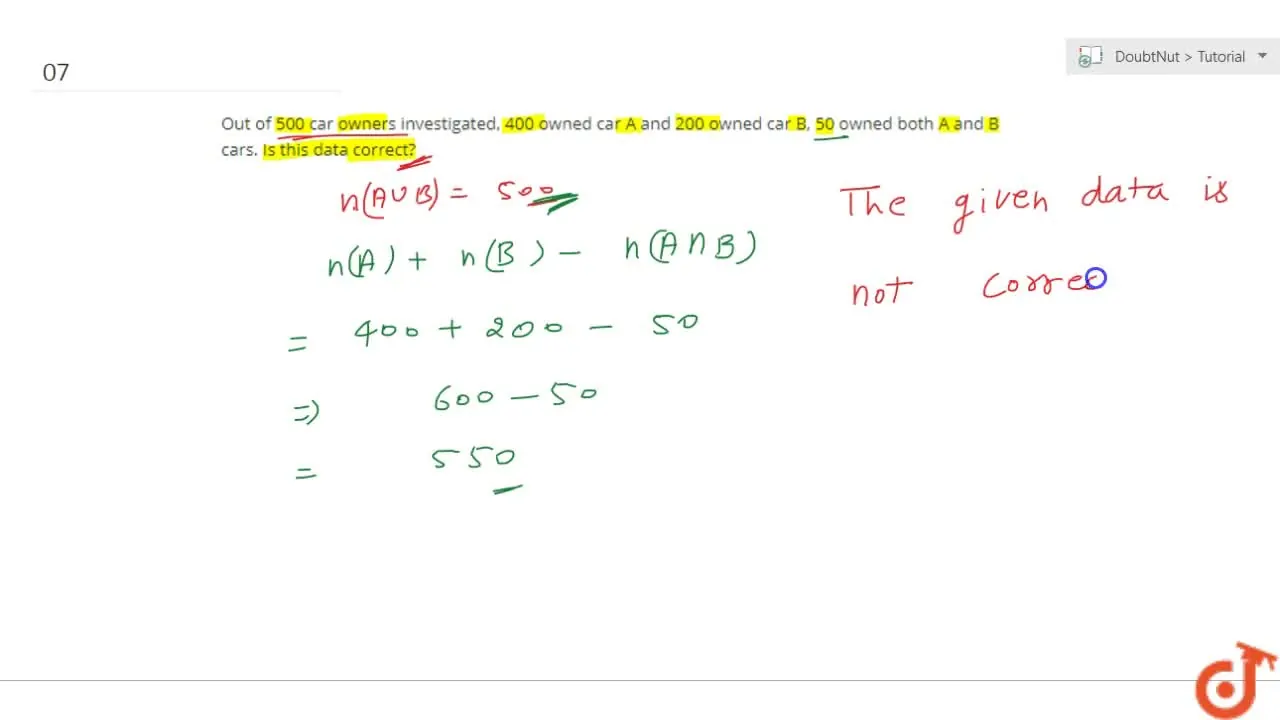Out of 500 car owners investigated, 400 owned car A and 200 owned car B, 50 owned both A and B cars. Is this data correct?
Number of elements in universal set(n(A∪B))=500
Number of elements in first set(n(A))=400
Number of elements in first set(n(B))=200
Number of elements in both sets(n(A∩B))=50
Now, we know,
n(A∪B)=n(A)+n(B)−n(A∩B)
n(A∪B)=400+200−50=550
But, we are given, n(A∪B)=500.
So, the data given is incorrect.
Related Playlists
- BOOK - NCERTCHAPTER - SETSEXERCISE - EXERCISE 1.67videos
SETS
- BOOK - NCERTCHAPTER - SETSEXERCISE - EXERCISE 1.412videos
SETS
- BOOK - NCERTCHAPTER - SETSEXERCISE - EXERCISE 1.26videos
SETS
- BOOK - NCERTCHAPTER - SEQUENCES AND SERIESEXERCISE - EXERCISE 9.56videos
SEQUENCES AND SERIES
- BOOK - NCERTCHAPTER - STATISTICSEXERCISE - EXERCISE 15.210videos
STATISTICS
Similar Questions
Out of 600 car owners investigated, 500 owned car A, 200 owned car B and 50 owned both A and B cars. Verify whether the given data is correct or not.
View SolutionOut of 500 car drivers, 400 are the owners of Maruti and 200 are the owners of Hundai. If 50 are the owners of both, then find the whether the datas are correct or not ?
View SolutionIn a survey, 70% of those surveyed owned a car and 75% of those surveyed owned a TV. If 55% owned both a car and a TV, what percent of those surveyed did not own either a car or a TV?
View SolutionIn a survey, 70% of those surveyed owned a car and 75% of those surveyed owned a TV. If 55% owned both a car and a TV, what percent of those surveyed did not own either a car or a TV?
View SolutionIn a certain town, 25% of the families own a phone and 15% own a car, 65% families own neither a phone nor a car and 2,000 families own both a car and a phone. Consider the following three statements :
(A) 5% families own both a car and a phone
(B) 35% families own either a car or a phone
(C ) 40,000 families live in the town
Then,View SolutionIn a certain town 25% families own a phone and 15% own a car 65% own neither a phone nor a car. 2000 families own both a car and a phone. Consider the following statements in this regard
(1) 10% families own both a car and a phone
(2) 35% families own neither a car or a phone
(3) 40,000 families live in the town
Which one of these statements are correct?View Solution1116 of the residents of a housing society own cars and 2033 of the car owners have purchased covered parking space. IF 130 of the residents parked in the open, how many residents when there in the society
View SolutionTwo cars a and B starts motion with a velocity of 10m/s and 20m/s respectively. Car a moves with a constant acceleration of 2.5m/s2 and car B have constant acceleration of 0.5m/s2 as shown in figure. Find when car A will over take car B. Dimension of car is negligible as compare to distance. Find the time after which car A over takes car B.
View SolutionIn a certain town 25% families own a phone and 15% own a car, 65% families own neither a phone nor a car. 2000 families own both a car and a phone. Consider the following statement in this regard.
1. 10% families own both a car and a phone
2. 35% families own either a car or a phone
3. 40000 families live in the town
Which statement(s) is / are correct ?View SolutionIn a certain town, 60% of the families own a car, 30% own a house and 20% own both car and house. If a family is randomly chosen, then what is the probability that this family owns a car or a house but not both?
View Solution


